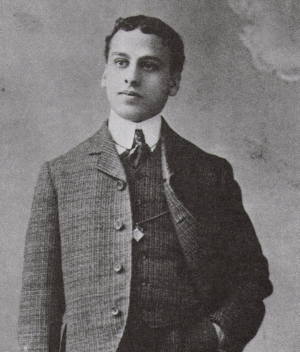 SKC Films Library SKC Films Library |
| SKC Films Library >> Technology >> Railroad Engineering and Operation >> Biography |
| Joshua Lionel Cowen model railroad namesake
Joshua Lionel Cowen was born in New York City on August 25, 1877. His name was originally spelled "Cohen," but he changed it to "Cowen" in 1910. A born tinkerer, he began his inventive life at the age of 7, when he whittled a miniature locomotive from a block of wood; he then tried to fit it with a tiny steam engine, but the locomotive exploded in his mother's kitchen. Despite being more of a tinkerer than a book reader, Cowen was able to enter the College of New York City in 1893, at the age of 16. He found studying to be less than fun, however, and dropped out after a short time. He would return and drop out again, then attend Columbia University for a brief time, and then give up college all together. In 1896, Cowen went to work at Henner & Anderson, a dry cell battery manufacturer. In 1897 he took a job as a battery lamp assembler at the Acme Lamp Company. The mechanical skills he learned at these jobs would serve him well in his future years. Cowen recieved his first patent in 1899, for a device that ignited a photographer's flash by the use of dry cell batteries to heat a wire fuse. That same year he was awarded a $12,000 contract from the United States Navy to adapt his device to detonate underwater mines. He received his second patent in 1900, for an improvement to his flash igniter. The money received for his mine fuses allowed Cowen to team with Harry C. Grant and found the Lionel Manufacturing Company. The company had nothing to manufacture, however, until 1901, when Cowen developed a battery-operated fan. Although the fan itself failed to gain a substantial market, the motor that powered it went on to make Cowen rich. In 1901, while walking down a Manhattan sidewalk, Cohen happened to look in a toy store window and see a wind-up toy train. That sight inspired him to fit one of his fan motors under a model of a railroad flatcar and to then place that flatcar on a circular track. The idea was that having something moving through the window display would attract customers to the store. He sold the concept to the store owner, and sure enough the store began attracting customers. The idea worked so well, in fact, that Cohen sold a total of twelve similar displays that year, half of which were sold to individuals rather than stores. By 1906 Cohen had added a variety of railroad cars to his displays, as well as some scale buildings. That year he added the trademark third rail to carry the current, and spaced the two outer rails at 2-1/8 inches. By now the clever businessman, Cohen called his new rail spacing "Standard Gauge" and had the name copyrighted. The gauge remained the industry standard for many years. In 1918, the Lionel Manufacturing Company became the Lionel Corporation. The Lionel Corporation continued to update its product line, and managed to stay afloat during the Depression years and was even able to overcome the metal shortages of the World War II years. By the mid-1950's, however, the public's interest in trains had begun to wane, and, in 1958, the company lost money for the first time since the Depression. In 1959, Cowen sold all his stock to his great-nephew, Roy Cohn, and retired from Lionel. Joshua Lionel Cohen died in Palm Beach, Florida, on September 8, 1965. SOURCES |
| SKC Films Library >> Technology >> Railroad Engineering and Operation >> Biography This page was last updated on August 15, 2017. |
